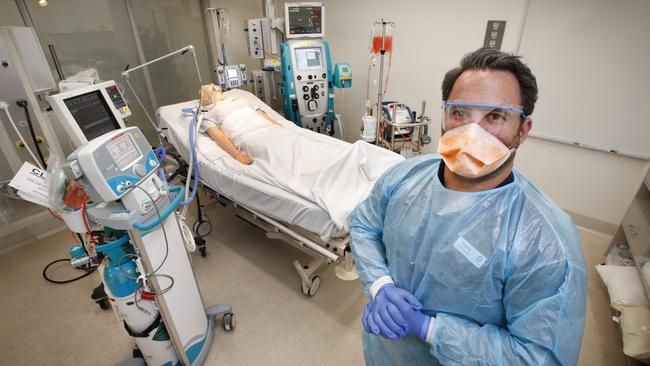Coronavirus: ICU beds could be overwhelmed in 10 days
If infections continue to rise at the current rate, Australia’s ICU beds will be overwhelmed in just 10 days’ time.

Australia could run out of ICU beds to treat coronavirus patients in as few as 10 days if infections continue to rise at the current rate of exponential growth, a new study has predicted.
The study published in the Medical Journal of Australia says Australia’s mortality rate from COVID-19 could be as high as that of Italy unless urgent measures are taken to slow the spread of infection.
Epidemiologists say it is still too early to assess whether social-distancing measures introduced by the federal government have had any impact on Australia’s curve of infections. But if the measures do not slow the rapid rate of growth in cases, mortality rates here could climb to in excess of 5 per cent.
In the MJA study, anaesthetist Hamish Meares and Macquarie University biostatistician Michael Jones calculated that based on Australia’s ICU bed capacity of about 2200, hospitals would be overwhelmed once the number of infections hit 22,000. However, hospitals around the country are preparing to double their ICU bed capacity.
“The model’s predictions are broadly supported by data from Italy and suggest that Australian hospitals do not currently have the capacity to accommodate possible demand and, as a result, the future mortality rate may be much higher than expected,” the authors say.
The case fatality rate from COVID-19 is estimated at between 1 per cent and 3 per cent, but in Italy the mortality rate has climbed as high as 9 per cent.
Australia has almost 2800 cases of COVID-19 and modelling by many epidemiologists predicts that at least 60 per cent of the population will become infected unless the growth in infections is slowed, with cases climbing to at least 30,000 a day at the pandemic’s peak.
New modelling by the University of Western Australia predicts that the government’s social-distancing measures are likely to cut infections by two-thirds to around 10,000 a day at the peak of the crisis.
As clinicians grow increasingly concerned about the capacity of hospitals to cope, there is also great concern among doctors that supplies of personal protective equipment are running low. The preservation of PPE was one of the factors prompting the federal government to call a halt to non-urgent elective surgery at all hospitals, but there was anger on Thursday that private hospitals would be able to continue normal surgery until April 1.
The Royal Australasian College of Surgeons hit out at the move. “This sort of decision can only be described as putting commercial interests before patient safety,” the College’s president Tony Sparnon and CEO John Biviano said in a letter.
“Many of our surgeons who work in private hospitals are appalled and are refusing to operate on non-critical cases.”
The Australian Society of Anaesthetists also denounced the reversal on elective surgery, saying it “continues a distressing pattern of confusing messages being shared in this crisis”.
“Our health system is not yet ready to cope with the likely massive demand for our services and this is especially so if private hospitals are not encouraged to cancel non-urgent surgeries like their public counterparts,” said Australian Society of Anaesthetists president Dr Suzi Nou.
As of 3pm on Thursday — the latest federal figures available — the number of COVID-19 infections recorded nationally was 2799 — an increase of 376 from the previous day.
NSW recorded an additional 190 infections, Victoria added 54 cases, South Australia had 38 new infections and Western Australia recorded 26 new cases.
The rise in national case numbers comes as Dr Meares and Professor Jones warn that the impending demand for intensive-care beds and ventilators “could overwhelm capacity in even the largest Australian hospitals in the near future”.
“Australia must immediately take all available measures to rapidly decrease the rate of new cases and radically increase the number of ICU beds otherwise we may face the same fate as Italy, or worse,” they write.
Dr Meares and Professor Jones based their calculations on a model that assumes for every 20 new cases of COVID-19, three will need admission to a low-acuity hospital ward and one will need ICU admission each day. Each patient is assumed to require ICU admission for 10 days.
Cases are increasing at increase at the rate of 20 per cent a day. Assuming that rate continues, if one ICU patient with COVID-19 is admitted to ICU on day one, within seven days the number of patients in ICU would be 31, and after 14 days it would be 200.
“Australia has around 2200 ICU beds, which implies if public health measures fail to curb the rate of growth, Australia’s ICU capacity will be exceeded at around 22,000 COVID-19 cases sometime around the 5th April, 2020.”
Hospitals are converting theatres previously used for other surgery into new ICU spaces and co-opting beds from other wards as ICU beds.
Hospitals are expected to double their ICU capacity by the time the epidemic peaks. However, there are serious concerns among doctors over whether enough skilled staff will be available to manage the new ICU load.








To join the conversation, please log in. Don't have an account? Register
Join the conversation, you are commenting as Logout